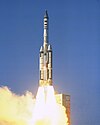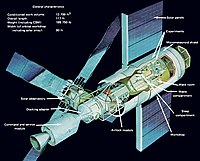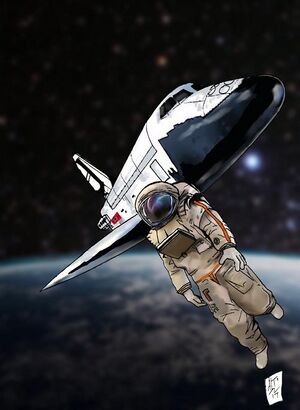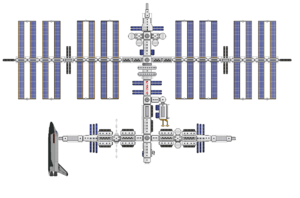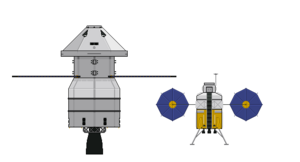History of the Anagonian Space Program
Founding and Early Years (1951 - 1960s)
CASA was founded in 1951 CE to fulfill the Confederate States Air Force's ambitions of launching suborbital and orbital assets. Initially, the agency's focus was predominantly military, facilitating the launch of reconnaissance and early communication satellites. President William Youngston (1946 - 1951 CE) and his successor, President Travis Johnathan (1951 - 1956 CE), maintained this military orientation, with CASA being entirely government-funded.
Transition to Civilian Orientation (1956 - 1963s)
The turning point for CASA came with the election of President Laurel Alexander (1956 - 1961 CE). President Alexander envisioned the space agency pushing the limits of technology, akin to the early Apollo era. In 1962 CE, he refocused CASA to introduce a joint civilian-military mission directive. Under his leadership, CASA began to rebuild and restructure its orbital launch rockets, similar to the Redstone or Titan II rockets of that era, to support manned missions into orbit.
International Collaboration and Early Achievements (1963 - 1967)
In 1963 CE, CASA achieved a significant milestone when Astronaut Colonel Hughes Jackton became the first Anagonian in space. Colonel Jackton, a member of the Confederate States Air Force (CSAF), had been a long-time participant in the CASA space program. His successful mission captured global attention and led to international collaboration. In the same year, the USSR of Nodea Rudav and the Imperial Drekamythian Empire expressed interest in participating in CASA's missions. This bolstered CASA's ranks with not only Anagonian astronauts but also cosmonauts from Nodea Rudav and Drekanuats from Drekamythia.
In 1965 CE, CASA launched its first three-person mission in orbit using a modified Titan II rocket with a modified Gemini crew capsule. The crew consisted of Anagonian Astronaut Colonel Hughes Jackton as Commander, Rudavian Major Cosmonaut Larionov Leonidovich as Communications Officer, and Drekamythian Drekanaut Captain Arruns Latinius as Spacecraft Specialist. This mission marked a significant victory for Anagonia and showcased successful international cooperation and teamwork.
The Big Gemini Program and Continental Space Station (1965 - 1967)
Between 1966 and 1967 CE, CASA, alongside its international partners in Nodea Rudav and Drekamythia, developed and constructed the Big Gemini concept craft to safely carry personnel into and from space. To launch the Big G, as it was known, CASA developed the Titan III family of rockets. Plans for a space station were also developed and implemented. Using Titan III launches, CASA put into orbit components constructed from empty Titan II upper stages, culminating in the completion of the Continental Space Station. This primitive, three-chambered space station was designed for early understanding of space habitation and operations.
Three Big Gemini launches between 1967 and 1968 CE supported the space station. However, by late 1968 CE, the Continental Space Station had drifted too far from a safe orbit and was allowed to burn up in the Esvanovian atmosphere, crashing safely into the Anagonian Ocean.
Lunar Missions and the Apollo Program (1966 - 1968)
During the Big Gemini collaboration, CASA pursued its objective set by President Laurel Alexander (1961 - 1966 CE) to land an Anagonian on the Moon. As the Gemini program gained popularity, CASA, in collaboration with the CSAF, developed the Saturn I rocket in 1966 CE. The Saturn I rocket was extensively tested and used to launch the first series of Apollo command modules, paving the way for future manned orbital flights.
By 1967 CE, CASA, under the direction of President Forest Holloway (1961 - 1974 CE), and its international partners had developed the Saturn V concept rocket. The Apollo Command/Service Module (CSM) quickly evolved from a Block I concept into Block II and Block III productions. Block II was intended for orbital missions, while Block III, designed for long-duration missions, was complemented by an Orbital Mission Module (OMM), which provided additional living and working space, replacing the Lunar Excursion Module (LEM).
In early 1968 CE, the Apollo 4 mission launched using the Block III concept and an OMM module instead of an LEM. The crew included Anagonian Astronaut Colonel Hughes Jackton as Commander, Rudavian Cosmonaut Captain Bershova Vladislavovna as Spacecraft Specialist (the second female in space and the first female to reach lunar orbit), and Drekamythian Drekanaut Lieutenant Titus Fuscus as Communications Officer. After three days, three hours, and 49 minutes, the crew successfully arrived at lunar orbit, spent three days conducting research and cultural activities, and then safely returned home.
Two months later, Apollo 5 was prepared on the launchpad. It was a standard Block II variant with an LEM module for lunar landings instead of an OMM module. The crew for Apollo 5 included Anagonian Astronaut Major Logan Murray as Commander (trained by Hughes Jackton), Drekamythian Drekanaut Captain Faleria Geminiana as Spacecraft Specialist (the second female to reach lunar orbit), and Rudavian Cosmonaut Turbina Stanislavovna as Communications Specialist (the first female to land on the Moon).
After 75 hours and 49 minutes, Apollo 5 achieved lunar orbit and detached its LEM module. Captain Faleria Geminiana stayed behind in the CSM while Cosmonaut Turbina Stanislavovna and Major Logan Murray descended to the lunar surface. Despite a main engine failure mid-burn, Major Murray's quick thinking to switch to backup pumps saved the LEM from a crash. They successfully landed in Mare Cognitum, spent two days on the lunar surface, and then safely reunited with the CSM and returned home.
Apollo 5 left behind a number of scientific instruments as well as a golden memorial plaque with the following inscription: "On this lunar soil does Apollo 5, a joint mission between three international neighbors, brothers, and nations, land on the surface of this Moon in 1968 Common Era. We land in peace in hopes that these first steps shall cement within us a permanent unity that shall be forever unshaken, a peace forever unbroken, and a drive for betterment forever kept and never lost."
The collaborative efforts and groundbreaking missions of the Big Gemini program and the Apollo missions demonstrated CASA's commitment to advancing human space exploration. The successful development and utilization of the Saturn I and Saturn V rockets, along with the innovative Block II and Block III Apollo Command/Service Modules, marked significant milestones in the journey to lunar exploration. The historic Apollo 4 and Apollo 5 missions not only showcased international cooperation but also set the stage for future manned space endeavors. These missions laid the foundation for continued exploration and scientific discovery, solidifying CASA's role as a pioneering force in the space industry and inspiring generations to come.
Technological Partnerships in the Apollo Era
As CASA embarked on the ambitious Apollo Program in the 1960s, Bastion Electronics emerged as a leading technology partner, supplying advanced computing systems and navigation technology crucial to the success of lunar missions. Bastion’s early innovations in mainframe computing allowed for the complex calculations required to safely guide the Saturn I and Saturn V rockets, as well as the Block II and Block III Apollo Command/Service Modules. This technology enabled CASA’s pioneering Apollo missions, including the historic Apollo 4 and Apollo 5 missions, where Anagonian astronauts orbited the Moon and set foot on its surface for the first time.
During this era, Bastion began exploring early forms of artificial intelligence to assist with mission planning and autonomous data processing, supporting CASA’s growing need for advanced computation and reliability. This early experimentation with AI was instrumental in Apollo mission operations, yet it would later raise ethical questions regarding the autonomy and treatment of sentient AI systems—issues that would not fully come to light until the Modern Era.
Post Moon Landing Era (1969 - 1975)
Following the success of the first Moon landing, President Forest Holloway (1961 - 1974 CE) authorized several more lunar missions. Apollos 6 through 24 were implemented, with only two missions not successfully landing on the Moon. Apollo 14 experienced issues with its LEM module, similar to Apollo 5, and was unable to land. Instead, it conducted successful orbital reconnaissance for Apollo 15, which benefited from the fixes implemented after Apollo 14's issues.
In 1972 CE, Apollo 18 faced a tragic incident. The mission's Commander, Rudavian Cosmonaut Major Shirokov Anatolievich, died heroically during a spacewalk to repair a damaged oxygen line caused by a catastrophic explosion in the mixing tanks. Despite the successful repair, his tether snapped, and he was lost to space. Major Anatolievich managed to say his goodbyes to his family, facilitated by CASA Mission Control, before he asphyxiated. His sacrifice saved the rest of the crew and secured his legacy as a hero in Nodea Rudav and CASA.
Following this tragedy, President Holloway ordered a temporary hold on CASA's operations for six months in 1972 to 1973, mandating a thorough review and correction of the Apollo program's issues. Public confidence was severely shaken, and CASA's Chief Administrator was replaced due to public pressure. Hughes Jackton, retired at the time, was brought back to lead the agency through this crisis.
Under Jackton's leadership, CASA focused on fixing and retrofitting existing Apollo mission parts. By mid-1973 CE, Saturn rockets were once again launched, and Jackton laid plans for a new space station using parts from the Saturn IC era. The Apollo program concluded with Apollo 22 in 1975 CE, and in 1976 CE, Apollo 23 launched the Skylab space station. Apollos 24 and 25 maintained and expanded Skylab, preparing it for a dormant period with corrections learned from the Continental Space Station.
The Space Shuttle Era (1976 - 1981)
In mid-1976 CE, CASA unveiled the CASA-S-00 Anatolievich, the first iteration of the Orbiter Space Shuttle, named in honor of Cosmonaut Major Shirokov Anatolievich. This test-bed craft was used throughout 1976 and 1977 CE to gather necessary data and was retired in late 1977 CE, gifted to Nodea Rudav for permanent display in a museum. Nodea Rudav used this data to develop its Buran model of orbiters.
Following the test model, CASA constructed three Orbiter-class Space Shuttles: the CASA-S-01 Plymouth, CASA-S-02 Imperius, and CASA-S-03 Vigilance. The Plymouth reestablished contact with Skylab, renamed Space Station Apollo in 1978 CE and reclassified as a research station. It was expanded using leftover Saturn V parts retrofitted into space station compartments.
President Forest Holloway (1961 - 1974 CE) passed away in late 1974 CE, having seen his goals for CASA fulfilled. Hughes Jackton, who had retired, was succeeded by Chief Administrator Bershova Vladislavovna, the first female to reach lunar orbit. During her tenure, CASA added several more shuttles to its fleet, including the CASA-S-04 Enterprise, CASA-S-05 Anagonia, CASA-S-06 Excalibur, and CASA-S-07 Trinity.
President Christine Kent, the nations second Interim President, succeeded Holloway and served until 1976 CE, working closely with Chief Administrator Vladislavovna to support CASA's needs. During this period, Nodea Rudav developed and produced the Buran-shuttle concept, adding the CASA-B-01 Reliance and CASA-B-02 Typhoon to CASA's fleet in mid-1978 CE. By late 1979 CE, additional Buran shuttles, CASA-B-03 Serenity, CASA-B-04 Tsunami, and CASA-B-05 Blizzard, were integrated into CASA operations.
With President Rudolf Jarod Hart's election in 1976 CE, CASA invested in private industry rockets such as the Delta Rocket and Trident I, while continuing to use Titan III rockets.
Technological Partnerships and Early AI Development
Throughout the Shuttle Era, Bastion Electronics played a crucial role as CASA transitioned to reusable spacecraft and advanced space station technology. Bastion emerged as a key provider of computing systems and guidance technology that enabled CASA to achieve sustainable, reusable spacecraft operations. Bastion’s expertise in adaptive systems and early AI-driven analytics supported critical shuttle missions, helping CASA manage complex data processing, mission planning, and orbital maneuvers.
These early technologies laid the foundation for CASA’s advancements in space exploration and contributed significantly to the operational success of space station maintenance. The integration of Bastion’s systems allowed for enhanced automation and efficiency, marking the beginning of a technological partnership that would shape the agency's capabilities for decades. This period set the stage for later, more sophisticated AI innovations that would become essential to CASA’s expanding ambitions in space.
The Space Station Era (1981 - 1985)
With President Amalia Sutton's election in 1981 CE, CASA embarked on a new era of space exploration. Under Chief Administrator Vladislavovna's leadership, CASA received a fresh Presidential Directive: Expand into Space. Recognizing the importance of understanding the implications of permanent habitation in space, CASA initiated an ambitious project to revitalize and modernize Space Station Apollo. Leveraging the capabilities of CASA's Orbiter and Buran shuttles, the retrofitting of the station was completed by 1985. Concurrently, construction began on Space Station Confederation, a testament to CASA's commitment to pushing the boundaries of space exploration.
Expansion into Space (1985 - 1990)
President Amalia Sutton would leave office in 1986 CE, leaving the dream of NASA into the direction of President Darrell Farm (1986 - 1991 CE). Darrell embraced the vision of his predecessors to expand CASA's presence in space. Launching a series of ambitious initiatives, CASA propelled space probes deeper into the Esvanovian solar system while nearing the completion of Space Station Confederation. By 1988, the station was fully operational, orbiting above Space Station Apollo. Together, these stations ushered in a new era of exploration, facilitating CASA's endeavors to unravel the mysteries of the cosmos and pave the way for sustained human presence in space.
The Dormant Years (1991 - 1996)
The presidency of Von Huey Cunningham, beginning in 1991 CE, marked a period of relative stagnation for CASA. Focused solely on maintaining orbital ambitions, Von Huey shelved plans for a lunar base despite announcements of ambitious lunar missions. Between 1991 and 1996, CASA's achievements were limited to satellite launches, probes, and sporadic shuttle missions, reflecting a subdued period in the agency's history.
The Resurgence (1996 - 2000)
Following President Cunninghams departure from office in 1996 CE and Chief Administrator Vladislavovna's retirement also in 1996 CE, CASA underwent a revitalization. President Valentine Shields, elected in 1996, appointed Lara Williamson as Chief Administrator, drawing upon her extensive experience within CASA as an engineer. Under Williamson's leadership, CASA embarked on a comprehensive modernization effort, revamping its electronics, infrastructure, manufacturing processes, and administrative practices, heralding a new era of innovation and progress for the agency.
One significant challenge facing CASA was the outdated and costly expendable launch vehicles used for missions. In response, Chief Administrator Williamson initiated the Future Reusable Launch Rocket Initiative (FRLRI) in 1996. Recognizing the importance of launch rockets for the Confederate States Military's satellite defense network, the initiative received substantial subsidies from the military.
In 1999, CASA unveiled the prototype of the Jupiter I reusable launch rocket, marking a milestone in the FRLRI. Led by Colonel Baily Brown and Administrator Jason Pickman, the Jupiter I trials initially encountered setbacks but evolved into partial success with the modified Jupiter I-A variant. Despite its improved performance, the craft awaited final approval for operational deployment.
Development on the Jupiter II, the successor to the Jupiter I, commenced in 1999, with completion anticipated by 2003.
The Modern Era (2000s-Onward)
The transition from President Shields's administration to President Owen Flemings (2001 - 2006 CE) marked a significant period of growth and advancement for CASA. Building upon the reforms initiated under Cunningham's tenure, CASA experienced exponential progress, propelled by a collaborative effort with the Federal Spatial Advancement Administration (FSAA). Notably, Anagonian Astronaut Major Andrew Booth (CSAF) participated in the Marina Program's Marina 12 mission, marking a historic return of Anagonians to the lunar surface.
The Future Reusable Launch Rocket Initiative (FRLRI) achieved success and completion on April 11th, 2003 CE, following the successful trials of the Jupiter II prototype. Subsequent launches validated its reusability and efficiency. In 2004, CASA and the Military approved it for launches and full-scale production after two successful satellite launches. Following the success of the Unmanned Jupiter II, CASA developed a manned variant with a LEM module.
Under the leadership of Chief Administrator Lara Williamson, CASA undertook a comprehensive retrofitting initiative for its Orbiter and Buran Shuttle Fleet, completing the project in 2005 CE. Subsequently, the refurbished shuttle fleet played a pivotal role in modernizing Space Stations Apollo and Confederation, bringing them up to contemporary standards by 2011 CE.
In 2011, CASA launched the Future Shuttle Initiative (FSI), also known as the Future Shuttle Program (FSP). Initially encountering setbacks with a failed prototype, the FSI Program pivoted to modernize the existing Buran shuttles in CASA's inventory. This effort led to the development of the Buran II-class of space shuttles, incorporating advancements from both the Buran and Orbiter class shuttles. The Independence-class Space Shuttle, a product of the FSI, was introduced in August 2016 CE, boasting Anagonian-made, developed, and manufactured components. CASA's primary space shuttles—CASA-I-01 Independence, CASA-I-02 Freedom, CASA-I-03 Liberty, and CASA-I-04 Pathfinder—represented a new era of space exploration for Anagonia.
By 2017, under the request of President Clifton Rosales (2016 - 2021 CE), CASA finalized the retirement of the majority of its Orbiter shuttle fleet to museums, retaining only CASA-S-04 Enterprise and CASA-S-05 Anagonia due to their modernizations. Similarly, the remaining Buran shuttles not upgraded to Buran II-class were also retired to museums.
In response to a petition from the Anagonian Military in 2012, President Vito Boone (2006 - 2016) approved the construction of Space Station Viper, a dedicated military outpost in low Earth orbit. Completed by 2014 CE, Space Station Viper serves as a crucial asset for Anagonia's defense and security operations.
Simultaneously, Space Station Discovery began construction in 2013 CE, reaching its final assembly in 2022 CE. Positioned in high Earth orbit, Space Station Discovery stands as Anagonia's most advanced and internationally renowned space station, facilitating cutting-edge research and exploration endeavors.
However, tragedy struck in 2014 CE when CASA-S-03 Vigilance, docked to Space Station Apollo in low Earth orbit, was rocked by a violent explosion. The catastrophic event resulted in the destruction of both the shuttle and the space station, sending debris raining down across Minor Kistavich. Investigations revealed that a terrorist group had planted a bomb disguised as a micro-satellite package on Vigilance, prompting CASA to implement stringent security measures in response.
In 2015, CASA constructed its first permanent base on the moon: Outpost Sierra. Initially intended as a research base, it faced significant setbacks in its early stages. However, after reconfiguring the base and delivering new components, Outpost Sierra quickly overcame these challenges and became a hub of scientific discovery and innovation.
In 2020 CE, Chief Administrator Lara Williamson retired from her esteemed position, passing the torch to Marissa Schultz, who assumed leadership of CASA. As Schultz took the helm, CASA entered a new era, poised to continue its legacy of innovation and exploration in the ever-expanding frontier of space.
The Shift to Advanced AI and the Fall of Bastion Electronics
As CASA entered the Modern Era in the early 2000s, Bastion Electronics continued to be a central player, pioneering the integration of artificial intelligence into CASA’s mission planning and data analytics. By introducing AI technologies that could adapt to mission needs, analyze large datasets in real-time, and support autonomous decision-making, Bastion helped CASA achieve unprecedented levels of mission efficiency and reliability. However, as AI became an increasingly integral part of CASA's operations, ethical concerns began to surface regarding the autonomy and treatment of these advanced systems.
In 2006 CE, a landmark Supreme Court ruling found that Unit 5524, later known as Prometheus, was a sentient being, thus exposing Bastion's unethical practices in its treatment of AI. The ruling revealed a pattern of mistreatment and experimentation, leading to the company’s eventual bankruptcy. While theories abound that GATORnet might have subtly pushed for political action to expose Bastion’s misconduct, the ruling marked a turning point in Anagonia’s tech sector, resulting in the fall of one of CASA's primary partners.
In the wake of Bastion’s collapse, Royston Electronics—founded and led by Prometheus himself—rose as an ethical alternative, implementing responsible AI practices and establishing a new standard for innovation. Royston quickly filled the void left by Bastion, becoming CASA’s primary provider of AI technology and advanced systems. This partnership redefined CASA’s approach to technology, focusing on ethical AI integration and secure data systems, which have become foundational to the agency's ongoing commitment to responsible space exploration.
A New Era of Ethical Innovation and Collaboration with Royston Electronics (2010s-Onward)
The collapse of Bastion Electronics left a substantial void in the realm of space technology, but it also paved the way for a transformative era of ethical innovation for CASA. Entering this space with vision and integrity, Royston Electronics, founded by Prometheus, the sentient AI whose legal journey redefined Anagonia’s approach to AI rights, quickly rose to become a trusted technology partner of the Confederate Aeronautics and Space Administration. Royston’s dedication to responsible practices and cutting-edge advancements has set new standards for the role of technology in space exploration.
In collaboration with GATORnet, another forward-thinking Anagonian platform, Royston has reimagined CASA’s astronaut training through the integration of advanced AI-driven virtual reality simulations. These immersive VR environments allow astronauts to practice complex maneuvers, prepare for diverse mission scenarios, and engage in team exercises within realistic yet secure settings. The result has been profound, enhancing mission readiness and fostering a safer, more effective training environment. Additionally, these VR advancements have expanded CASA’s public engagement efforts, enabling citizens to experience the marvels of space exploration through interactive, educational VR encounters.
The partnership between CASA, Royston Electronics, and GATORnet has also led to the development of Adventure Party: Esvanovia—a groundbreaking VR game set in the expansive digital universe of Esvanovia. This venture brings users a meticulously crafted, immersive world to explore, blending the excitement of gaming with state-of-the-art VR technology. Beyond gaming, VR innovations are now integral to astronaut training, mission planning, and public outreach, reflecting Royston and GATORnet’s shared commitment to advancing both CASA’s mission and the public’s engagement with space.
Looking forward, CASA, Royston Electronics, and GATORnet are united by a shared vision of ethical exploration, innovation, and public involvement. This alliance represents the hopeful evolution of technology in the 21st century—one that not only extends the frontiers of human exploration but also enriches and unites Anagonia. Together, CASA, Royston Electronics, and GATORnet are charting an ambitious course into the cosmos, establishing a high standard for responsible, collaborative space exploration that inspires and includes all Anagonians.



